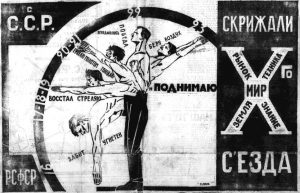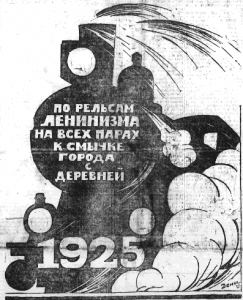By Zinaida Osipova
In the holiday month of December, while many Americans celebrate Christmas, Russians decorate their trees for New Year’s Eve. The reason for the difference goes back to the Soviet ideology that strongly antagonized religion and thus disfavored the celebration of Christmas. One current Russian New Year’s tradition is watching the President’s address five minutes before midnight; there, he summarizes events of the ending year and offers his New Year’s wishes to the nation. What was New Year’s Day like a century ago, in the nascent Soviet Union, as the new society came into being and began to highlight this holiday? The Soviet newspaper Pravda (meaning “truth”) sheds light on the matter: the first issue of the year typically featured its summary of the ending year and hopes for the coming one. Moreover, as the Soviet government grew stronger, and as ideology shifted toward creating the so-called New Man, the paper’s New Year’s wishes served as a means to emphasize societal goals.
Pravda’s first post-Revolutionary issue that came out on New Year’s Day was in 1919. The front page featured an article titled “New Year, New Fight, New Happiness,” discussing the drastic revolutionary changes. The article admitted that occasional regional rebelling under the influence of the white guards and the existing problems within the Soviet government were deplorable, “but this only casts a shadow on [the fact that] the Soviet authority has become a genuine authority…”[1] Written in the midst of the Civil War, the article discarded the fact of the war as rebellions under the white guards’ influence. Of course, the Whites would disagree (see a 1919 piece of the White Army propaganda optimistic about the Whites’ winning the war https://sites.miamioh.edu/havighurst/2018/10/22/who-is-kolchak/). The article ended with a note, celebrating “the new happiness, bright, beautiful happiness of the liberated humankind.” Another article in the issue, “New Year’s Wishes” campaigned for workers’ unity and success.[2] In 1919, Pravda used the New Year’s theme to disseminate its views to the readers while acknowledging the holiday.
In 1920, the New Year Day’s issue of Pravda was not as optimistic as that of the previous year: there were no articles dedicated specifically to holiday wishes. The front-page article “The Year 1919” informed its readers about difficulties that had arisen due to the unstable situation at the front. It mentioned the hope that the New Year would be “the year of our decisive victory” and “the beginning of peaceful work.”[3] Here, the Party’s anxiety over the uncertain future overshadowed any theme of festivities.
In 1921, the front-page article “The Party on the Occasion of the New Year” (Partiya k Novomu godu) proclaimed that “It is not with wishes of nonchalant petty bourgeois (meshchanskoye) happiness that we address all our Party comrades.” Indeed, their address emphasized combat, but of a different type than did the previous two years’ addresses – the “combat at the economic (khozyaystvenniy) front.” The next page featured a poem dedicated to the year 1921 and the spirit of the revolution.[4] As the Civil War was coming to an end, the Party newspaper directed its attention away from winning power to motivating people to work for their power for the benefit of the country.
In 1922, the New Year’s spirit was present in the newspaper’s illustration combining the holiday theme and Soviet propaganda. Titled “‘Freezing Boys,” the image depicts the commanders of the Anti-Bolshevik movements: Pyotr Wrangel, Semyon Petliura, Nestor Makhno and Boris Savinkov. They are freezing under the pine tree (since 1922, the “Red tree” (krasnaya yolka), which substituted for the Christmas tree until 1927, when it was deemed unfit for Soviet revelers) on a snowy (presumably) New Year’s night. [5]
Image on the front page of Pravda, January 1, 1922
Besides the image, the front page featured an address printed in the large font and immediately catching the reader’s attention: “Remember, comrades: New Year – new graves in Povolzhye [region], if the giving hand of workers and peasants becomes scanty. Our New Year’s wishes: victory over famine, recovery of industry, good harvest, good proletarian revolution in the whole world.” The theme of restoring the devastated country ran through the article titled “New Year,” proclaiming “less noise – more work” (men’she shumu – bol’she dela). Additionally, Pravda’s “New Year” and “New Year’s Thoughts” on the following page dedicated much attention to discussing the failures of capitalist counties. As in the previous year, the 1922 issue featured a New Year’s poem inspiring people to embark on a “labor journey.”[6] By discussing capitalist countries’ misfortunes, the newspaper emphasized that the situation was not grave in the Soviet Union by comparison and that hard work would help the country overcome its misfortunes.
In 1923, the first issue of Pravda came out on January 3, featuring a half-page illustration demonstrating the different stages the Soviet proletarian had supposedly underwent since 1916: from being downtrodden to triumphing over their oppressors in 1922 to lifting up the world in 1923. The “New Year’s” (Novye gody) article discussed the arrival of the new time, “years that will be remembered by our descendants as the most glorious, most heroic time in human history.” As opposed to the years between 1919 and 1922, the New Year’s address emphasized that the battle against the wealthy oppressors of the proletariat is destined to be triumphant.[7] Interestingly, the first issue of 1923 featured “Comrade [Lev] Trotsky’s New Year’s Wishes to the Japanese Nation,” which nonetheless focused on Russia’s efforts to reduce worldwide militarism and only superficially mentioned Japan and “all other nations” in the short actual wishes of success in the coming year.[8] Congruent with the front-page illustration, the party’s voice was more confident in 1923 than in had been just a few years before.
Image on the front page of Pravda, January 3, 1923
A similar theme is present on the front page of the year 1924: the article “Ten Years” proclaimed that “ten years ago, the ‘normal,’ ‘peaceful,’ ‘prewar’ capitalism passed into oblivion.” “A period of revolutionary rebirth of society” would bring back the peaceful state, but “it will be not capitalist society; it will be the society of a liberated proletariat.” Alongside these pronouncements, an article by Mikhail Koltsov entitled “New Year’s Toasts” published Aristarkh Petrovich’s toasts from the past years, starting in 1913.[9] The theme of making history and its very fast movement grew stronger as the Soviet Union established its foundations.
Pravda’s first issue of 1925 featured an article “Happy New Year” (S novym godom) where instead of delivering the celebratory wishes suggested by the title, the author discussed his hopes that soon, the years would be counted from November 7, the birthday of “social justice.” Until then, the author conceded, January 1’s New Year could be celebrated conditionally.
The theme of fast movement in the image from the front page of Pravda, January 1, 1925
Between years 1926 and 1928, the front page of the first issue of the year avoided using the words “New Year,” except to mock bourgeois countries. Between the years 1925 and 1928, Pravda focused on summarizing what had been done and how much there was to do. Instead of New Year’s wishes, the newspaper published articles, “Financial Objectives of 1925,” “We Demand” in 1927, “Goals of the Election Campaign” in 1928 or not deeming the holiday front-page worthy altogether in 1926. It is only in 1929 that the words “New Year’s” (Novogodnyee) appeared again on the front page, even if in quotation marks.
The newspaper’s first issue of the year gradually evolved from New Year’s wishes of stabilizing the situation to new year’s goals for the established new state. In both cases, the first issue of the year directly reflected the country’s situation, from the ongoing war and famine to the needs of a developing new country. By looking at the New Year’s addresses, we can trace the new country’s shifts in its power and its gradual shedding of the holiday spirit.
Bibliography
Makarova, Yulia Vladimirovna. “Антирелигиозное воспитание пионеров В 1920-х гг. в СССР [Anti-Religious Education of Pioneers in 1920s in the USSR].” Преподаватель XXI век [Teacher XXI Century] 3 (2015).
Pravda: January 1, 1919, 1920, 1921, 1922, 1924, 1925, 1926, 1927, 1928, 1929. January 3, 1923.
[1] Pravda, January 1, 1919: 1.
[2] Ibid., 1-2.
[3] Pravda, January 1, 1920: 1.
[4] Pravda, January 1, 1921: 1-2.
[5] Yulia Vladimirovna Makarova, “Антирелигиозное воспитание пионеров В 1920-х гг. в СССР [Anti-Religious Education of Pioneers in 1920s in the USSR],” Преподаватель XXI век [Teacher XXI Century] 3 (2015): 4.
[6] Pravda, January 1, 1922: 1-2.
[7] Pravda, January 3, 1923: 1.
[8] Ibid., 2.
[9] Pravda, January 1, 1924: 1.



